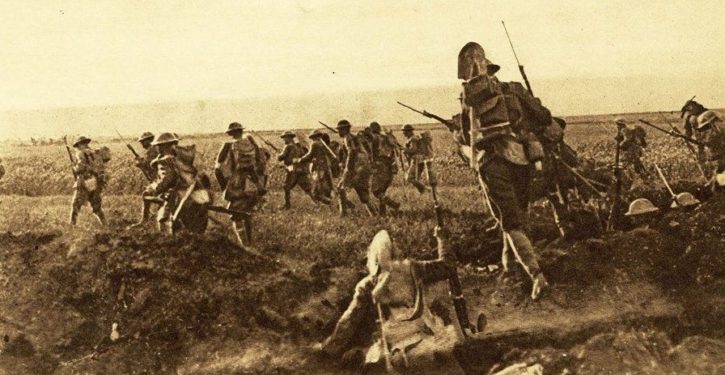
In some way, it seems emblematic of the return of history that this year’s Memorial Day falls on the 100-year anniversary of a turning point in World War I.
On 28 May 1918, U.S. troops under American command executed their first independent operation in the battle of the Western Allies to defeat Germany in northern France. The objective – to capture and hold the town of Cantigny in Picardy – wasn’t a big one. And the American infantrymen who seized and held the town didn’t do it without help from French aircraft and tanks.
The Americans even had to borrow heavy artillery from the French too, in order to pound the German positions before taking the town.
Will this presidential election be the most important in American history?
But the battle at Cantigny was a chance for the Americans to prove themselves: to prove they could plan and execute an operation on their own, and thus should be assigned missions as a coherent U.S. force, instead of being parted out all over the theater under British and French field commanders.
With this small but crucial operation, the Yanks proved exactly that. They had been arriving in France since June 1917, and – although in need of training and integration – had seen action under Allied command in other battles since the previous autumn. But Cantigny was the first opportunity for the American Expeditionary Force (AEF) under General John J. Pershing to demonstrate that it could function as a fighting force and be entrusted with distinctive campaign objectives.
Although no one knew it at the time, the armistice of November 1918 was less than six months away. The German army had launched its 1918 spring offensive in March, with a push westward along the Somme River. The urgency of the spring offensive for the Germans was that the arrival of American forces – who were entering France at a rate of about 10,000 a week by then – would soon tip conditions in the Western Allies’ favor.

The map had been static, and the butcher’s bill of trench warfare in northwestern Europe mind-boggling, since early 1915. Russia, originally part of the Triple Entente with Britain and France, had bowed out of the war shortly after the revolution in November 1917, leaving the Kaiser with some breathing room to the East. The German spring offensive was intended to push the remaining members of the Entente as far west as possible before they could integrate the arriving Americans. At the very least, Germany could make them fight to retake territory in France and Belgium that they could not afford to cede in a political settlement.
With the initial drive along the Somme, the German army made further inroads into Allied-held territory than at any time since 1914. Yet both of the German operations mounted in March and April of 1918 – “Michael” and “Georgette” – ultimately stalled, as French and British units formed new defensible positions and held out against flagging German onslaughts.
A reminder of the horrific toll of combat in this grotesquely sanguinary war is the set of casualty figures for each side between 21 March and 30 April 1918: 255,000 killed, wounded, and missing for the Allies, and 239,000 for Germany. In the British Third Army alone, some 15,000 died, and many reportedly have no known grave. Whole divisions took such heavy losses that they had to be removed from the order of battle after a few short weeks.
The Americans suffered virtually all of our 53,000-plus combat deaths between Cantigny, at the end of May, and the 11 November armistice. But in one sense, that wasn’t for lack of trying on Germany’s part. The Germans made extensive use of mustard gas in World War I, and researchers learned after the war that arriving U.S. troops were deliberately targeted during the build-up period from mid-1917 to early 1918.

Indeed, according to a U.S. Army study done in the 1950s, the sector at Cantigny was originally supposed to be assigned to the U.S. 1st Division’s 18th Infantry Regiment. But that regiment was “so badly gassed on the night of 3-4 May” that it was unable to prepare for the attack on the town when the requirement emerged.

It emerged in mid-late May 1918, when the Germans, stalled along the Somme, moved up to launch a new offensive southeast of the Somme front on the Aisne. Their hope was to draw the core of the fight further inland – away from the coast, which the British fleet effectively controlled at that point – and split the French and British forces to render them less effective.
With the 18th out of the fight for the time being, the task at Cantigny fell to the 28th Infantry Regiment. Both regiments were part of one of the most storied of U.S. fighting units: the U.S. 1st Division, nicknamed the Big Red One.
The 1st Division had been formed from existing units a year before, shortly after the U.S. formally entered World War I. Under the command of Major General Robert L. Bullard at the time of Cantigny, the Big Red One had seen its first action in October 1917, when it fired the first American shot of the war in support of a French operation at Sommerviller, south of Metz near Nancy.
In May 1918, the chief of operations, or “G-3,” for the 1st Division was Lieutenant Colonel George C. Marshall, a protege of General Pershing and lauded for his skill in coordinating allied operations. It was he who planned the attack on Cantigny, which the Germans had seized during their Somme offensive that spring, and were using – because of its elevation in the surrounding countryside – as a surveillance point for artillery direction.

The 28th, meanwhile, had been pulled from duty on the U.S.-Mexico border to become part of the Big Red One when the division was formed in 1917. Colonel Hansen Ely commanded it at Cantigny, augmented by two combat-capable companies of infantry from the earlier-gassed 18th.

At 6:45 AM on 28 May 1918, supported by fire from the borrowed French guns – manned by U.S. soldiers – along with French aircraft and French tankers from the 5th Tank Battalion, the 1st Battalion of the 28th Infantry Regiment led the assault on Cantigny.
At 06:45 [H Hour], 28 May 1918, American Soldiers of the 28th Infantry Regiment left their jump-off trenches following an hour-long artillery preparation. Part of the preparation was counter-battery fire directed at German artillery positions. A rolling barrage, advancing 100 meters every two minutes, was calculated to give the attacking troops time to keep up with it.
The 28th Infantry Regiment (Colonel Hansen Ely, commanding) plus two companies of the 18th Infantry, three machine-gun companies and a company of engineers (3,564 men), captured Cantigny from the German Eighteenth Army. The village was situated on high ground surrounded by woods, making it an ideal observation post for German artillery.
Because the Americans did not have them in sufficient quantity, the French provided air cover, 368 heavy artillery pieces, trench mortars, tanks, and flamethrowers. The French Schneider tanks were from the French 5th Tank Battalion. Their primary purpose was to eliminate German machine gun positions. With this massive support, and advancing on schedule behind the creeping artillery barrage, the 28th Infantry took the village in 30 minutes. It then continued on to its final objective roughly a half kilometer beyond the village.
Taking the objective turned out to be the easy part. Holding Cantigny, and the high ground where the German artillery observation post had been manned, was harder, as the Germans mounted one counterattack after another in the next 48 hours, supported by relentless shelling, attempting to retake it. At one point, “a company of the 1st Battalion of the 26th Infantry commanded by Major Theodore Roosevelt, Jr. was used to reinforce a weak spot in the American line.”

Throughout much of the fight, the infantry received fire support from a battery of the 1st Battalion of the 5th Field Artillery Regiment, commanded in 1918 by Major Robert R. McCormick (promoted to lieutenant colonel a few weeks later), also the longtime publisher of the Chicago Tribune.
The 1st Battalion, 5th Field Artillery is the oldest Army unit still in an active status, having been commissioned in January 1776 and commanded during the Revolutionary War by Captain Alexander Hamilton. It has fought in every major conflict since the birth of the American nation; in World War I, it was a unit of the Big Red One.
Still with the 1st Division, and now based at Fort Riley, KS, the 1st Battalion deployed multiple times to Iraq since participating in Iraqi Freedom in 2003, finally returning home with the troop drawdown in 2011.


Back at Cantigny, in 1918, the U.S. forces and their helpers did withstand the German counterattacks, and claimed the key terrain for the Allies. The Americans took losses of 199 killed in action, and another 1,400 wounded, while capturing at least 100 German prisoners (a number also given as up to 350; the more conservative figure is used here).


The success, although relatively minor in the context of the entire Western front, came at a significant time, just as the French were taking a tremendous beating under the German assault in the new Aisne offensive nearby.

The American success at Cantigny was a morale-booster in more ways than one. Besides denying the Germans a particularly useful artillery spotting position, it showed that the U.S. troops shouldering their nationally commanded operational role would be an effective “force multiplier.” They wouldn’t just take some of the load off the French and British forces. They would expand the scope and pace of what could be accomplished.
The U.S. attacking force at Cantigny began receiving relief from other units by 30 May. Reportedly:
[T]he soldiers were exhausted from the strain of continual shelling. As their commander, Colonel Hanson E. Ely, remembered: They could only stagger back, hollow-eyed with sunken cheeks, and if one stopped for a moment he would fall asleep.
It was speculated in analysis after the war that the Americans at Cantigny, like others in many engagements, had been partially debilitated beforehand by the German gas attacks – even when they weren’t among the worst-hit.

Some of the 199 dead from Cantigny still lie at the Somme American Cemetery in Bony, France. These, and their compatriots in graves across America, are the men we honor on Memorial Day each year: the ones who came back not with their shields, but on them.
Their names are also engraved on the 1st Division monument to the battle at Cantigny, placed in 1937 along the road just outside the town — which was rebuilt after the war and is now a slow-paced rural burg with a population of about 120.
There is an imposing memorial inside the town limits, with a larger monument and a museum. But the divisional monument, with the names of the war dead engraved on it, is the attraction for the 1st Division family: for its soldiers past and present, their relatives and descendants, the historians and chroniclers – and the French, the allied family who fought by their side.

One hundred years on from Cantigny, there is a sense today of waking up to reality again. In 2018, we are being hit with waves of recognition: that we are still human, a people with a past, a species that lives inescapably in time, with tethers of spun steel to those who have gone before. Nothing we have done has enabled us to transcend those conditions. It still matters today, as it mattered a century ago, that a few thousand hard-breathing young Americans, their health probably compromised by mustard gas from weeks earlier, took back a hill held by the Germans, and were able to hang onto it under artillery assault for three days before being relieved.
It matters that 199 men died in that battle. It matters that their lead unit, the 1st Battalion, 28th Infantry Regiment, was activated again in December 2015, after multiple deactivations over the preceding century. The 1st Battalion has been called the “Black Lions” since their victory at Cantigny, and has seen service in World War II, Vietnam, Iraq, and Afghanistan. Now, in a newer Army, and under the 3rd Infantry Division at Fort Benning, GA, they roar again.

And it matters that the red-legs of the 1st Battalion, 5th Field Artillery – “Hamilton’s Own,” born in the fires of revolution in 1776 – still stand watch over us, and that the regimental motto of the 5th Field Artillery, whose units have fought at Trenton and Yorktown, Manassas and Gettysburg, in Sicily and Normandy, in Vietnam and Desert Storm, at Samarra and Kirkuk, and 100 years ago at Cantigny, is still “Faithful and True.”





